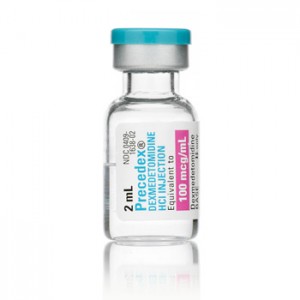 Dexmedetomidine is an alpha-2 agonist structurally related to clonidinea drug primarily used for hypertension, but also used intraspinally for pain management. It differs from clonidine because it has an eight times greater affinity for the alpha-2 receptor and, being a dextrorotatory isomer of medetomidine, it has fewer cardiovascular side effects than clonidine.
Dexmedetomidine is an alpha-2 agonist structurally related to clonidinea drug primarily used for hypertension, but also used intraspinally for pain management. It differs from clonidine because it has an eight times greater affinity for the alpha-2 receptor and, being a dextrorotatory isomer of medetomidine, it has fewer cardiovascular side effects than clonidine.
Dexmedetomidine (Dex) was initially approved by the FDA in 1999 for the sedation of intubated patients in critical care settings for less than 24 hours. The drug has three unique properties: 1) it is a sedative that allows for an interactive form of sedation on patients in ICU; 2) it has analgesic properties that may reduce concomitant use of opioids in surgical patients; and 3) it is accompanied by virtually no respiratory depression.
The mechanism of action of Dex, as previously stated, is an alpha-2 receptor agonist interacting as a subgroup of noradrenergic receptors. In addition to its sedative effects, the drug has significant analgesic qualities, and has been labelled an “analgesic-sparing” product by the FDA. The analgesia with Dex is mediated primarily through its interactions of the alpha-2 receptors within the spinal cord.
A study of intrathecal Dex versus bupivacaine and fentanyl in major abdominal cancer surgery was conducted at the South Egypt Cancer Institute in Assiut, Egypt. The purpose of this study was to gain experience utilizing the intrathecal alpha-2 adrenal receptor agonists in the treatment of pain. The study was a randomized, double-blind trial performed at an academic medical center where ninety patients were broken into sub-groups of thirtythe first group receiving ten milligrams of bupivacaine; the second group ten milligrams of bupivacaine plus five micrograms of Dex; and the third group ten milligrams of bupivacaine, five micrograms of Dex, and twenty-five micrograms of fentanyl. It was found that bupivacaine with Dex, given either with or without the fentanyl, showed a greater clinical effect, and also demonstrated the drug’s opioid-sparing effect.
Another study entitled, “The Effect of Low Dose Dexmedetomidine and-or Clonidine” was conducted by G.E. Kanazi, et al., to compare the onset and duration of sensory and motor blockade after the administration of intrathecal bupivicane with either Dex or clonidine. The conclusion of this study showed that the supplementation of bupivicane with a low dose of intrathecal Dex or clonidine produces a significantly shorter onset of motor blockade, and a significant longer sensory and motor block than bupivacaine used alone.
A study in 1998 by Dr. Lawrence Poree entitled, “The Analgesic Potency of Dexmedetomidine is Enhanced after Nerve Injury: A Possible Role in Peripheral Alpha 2 Adrenoreceptors” investigated the analgesic potency of Dex with ratsboth for the treatment of pain whether after ligation of their L5-6 spinal nerves or normal nerves. Ligation of their L5-6- spinal nerves produced chronic mechanical and thermal hyperanalgesia. The study concludes that analgesic potency of Dex was enhanced after nerve injury at the site of action outside the central nervous system. Very interesting compound and more studies are needed to consider for clinical use.
For more drug reviews, visit Hartley Medical’s Knowledge Center by clicking here.


Leave A Comment